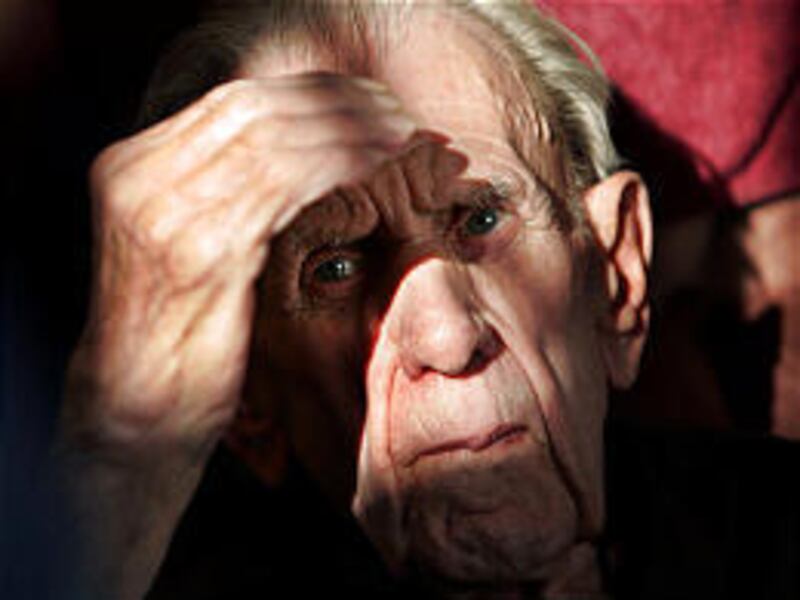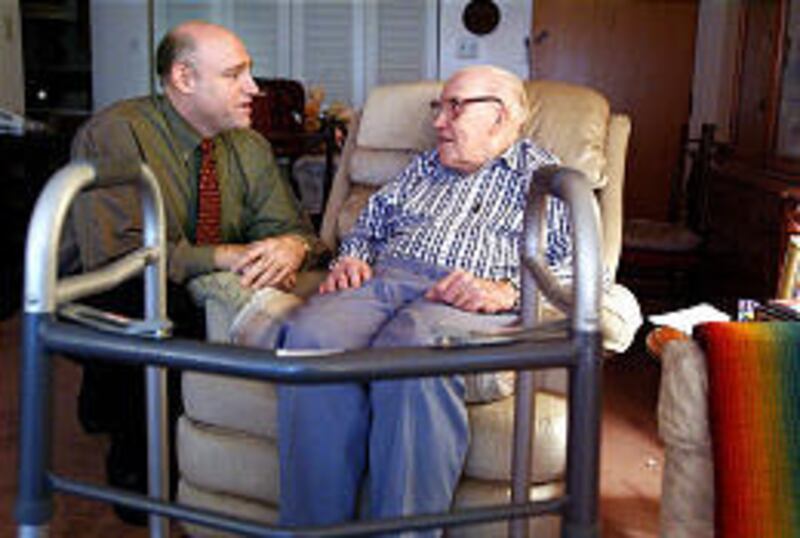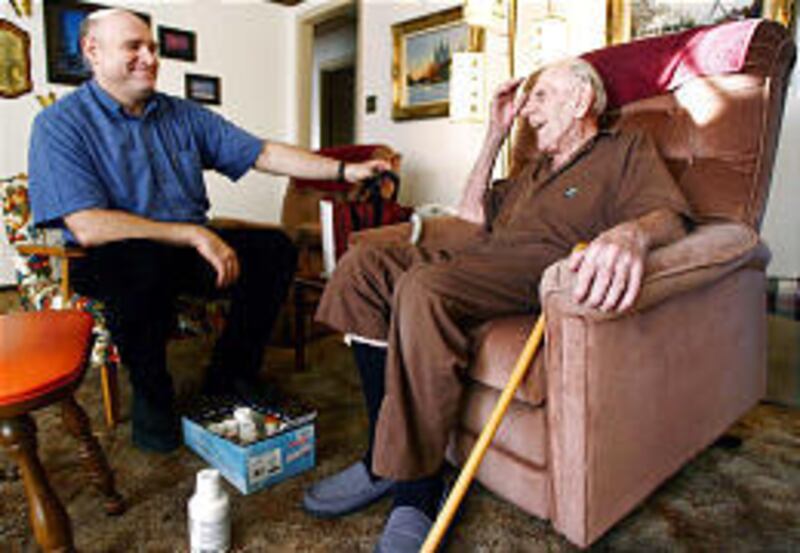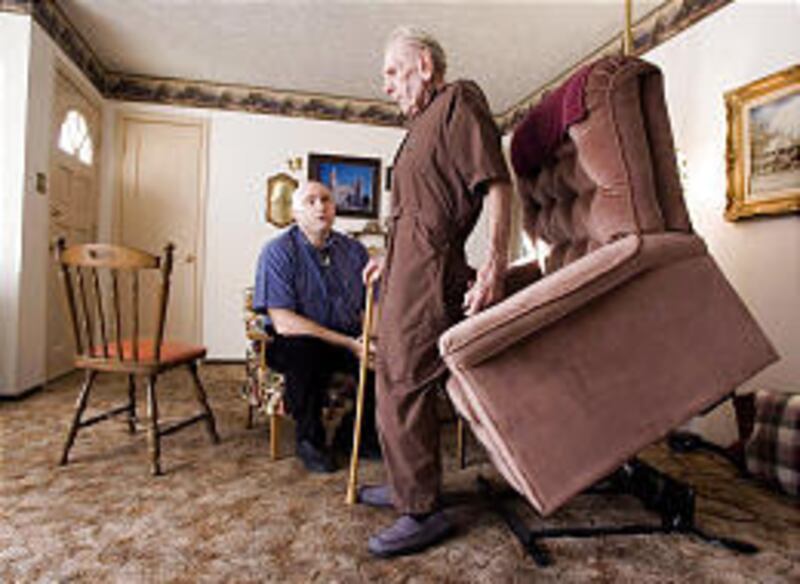Like many patients with the kind of pain that can make a person want to kill herself, Marcia Solum has suffered at the hands of a medical system that is struggling to do the right thing.
As her back pain worsened to the point that it hurt just to open her mouth, Solum went from doctor to surgeon to doctor to surgeon looking for help. When two surgeries only intensified the pain, the former buyer for O.C. Tanner asked for enough medication to make life bearable — and was accused of being an addict. It took four years to find a doctor who provided any relief.
Now on a morphine pump that has reduced her pain to a tolerable "5," Solum falls into the category of patients at the heart of a national debate: Are people in chronic pain being adequately treated?
At the debate's core is the love/hate affair with the powerful class of pain medications known as opioids. The painkillers may deliver an incomparable level of relief to some patients with severe pain, but they also have a downside. The most notorious example, OxyContin, has been blamed for addiction, crime and overdose deaths.
Faced with these unintended consequences and trying to sort out who's genuinely miserable from those just seeking a fix, doctors have become acutely aware that they must get it right. They want to provide relief, but they also want to keep people safe and stay out of trouble themselves — since doctors have been sued for undertreating pain and jailed for overtreating it.
The perception among doctors is that the regulatory environment has become more hostile, says Micke Brown, director of advocacy for the American Pain Foundation, headquartered in Baltimore. "Many health care providers are running scared," especially primary care physicians, she says. "Some are even backing away from managing people's pain."
"Stand up and look around the room," says pain management doctor Lynn Webster, who heads the Utah Academy of Pain. "At some point in their life, every other person will have intractable, protracted pain . . . not just for days or weeks but for months or longer." Pain management, he concludes, "should be a very personal issue to everyone."
Personal because the numbers are clear: One in two adults will experience severe, chronic pain.
For some the pain will come at the end of life. For others it will be pain that lingers for decades, set off by injury or illness or even by something that defies diagnosis. What doctors understand about pain now that they didn't just 10 years ago is that chronic pain is often a malfunction of the nervous system, itself a neurobiological disease.
This new understanding, however, doesn't mean that pain is always adequately treated or that it isn't still dismissed as the complaint of malingering, addicted or merely difficult patients.
Modern pain management is not a core class for doctors in training, and there are few medical residency programs that focus on pain. While some states require or encourage continuing education in pain management, Utah does not. Only a small number of Utah physicians specialize in pain management; the bulk of pain care is left to primary care physicians. And, "as people find it more difficult to access health care in general, there's less availability of pain management," says Dr. Sharon Weinstein, associate professor and director of pain medicine and palliative care at Huntsman Cancer Institute and the VA.
Pain management doctor Webster is an opioid advocate who recently co-hosted a symposium called "Opioids: The Good, the Bad and the Facts" that drew 200 health care professionals. He argues that the undertreatment of pain is "still a major problem" in Utah, in part because of doctors' fears of punishment by the federal Drug Enforcement Agency (DEA) and the state Division of Occupational and Professional Licensing (DOPL).
The shadow of Dr. Robert Weitzel still looms over many Utah doctors, says Dr. Bruce Chamberlain, medical director of Harmony Home Health and Hospice. "There's a lot of fear that a family or someone could come back later" and charge a doctor with overmedicating patients. Weitzel, a psychiatrist, was at first convicted of killing several elderly patients; and even though he was acquitted at retrial, the case, Chamberlain says, "clearly delivered a negative message to doctors."
Even more chilling, says Webster of Lifetree Pain Clinic, was the 2004 conviction of Virginia doctor William Hurwitz, who was sentenced to 25 years in prison for "drug trafficking" for writing prescriptions that resulted in one death and several injuries. The government's expert witness, a Utah doctor, argued that the use of "high dose" opioid therapy is an indication of drug abuse in populations with chronic non-cancer pain. Eight past presidents of the American Pain Society, including doctors from Johns Hopkins University and Memorial Sloan-Kettering Cancer Center, later wrote a letter rebutting that assessment. Even physicians who specialize in treating pain may not agree on how it should be done or on what's adequate or excessive.
Some primary care doctors won't prescribe any narcotic pain medication, and some prescribe, but in doses that may be too small or for periods of time that aren't sufficient. Often, they're trying to follow practice guidelines that don't consider individual needs, says hospice doctor Chamberlain. He describes geriatric patients who hurt so badly they can't go shopping or take a short walk, because they've been told to take a drug every six hours, though it relieves their pain for only four. When it wears off early, "the doctor's looking at a watch saying 'It's two hours before I can give you another inadequate dose.' "
In Utah, a Department of Health task force is wrestling with pain care policy and opioid use. Health care professionals are trying, says state epidemiologist Dr. Robert Rolfs, to "not cause harm" as they tackle the conundrum of protecting the public both from suffering and from the drugs designed to alleviate it, including opioids. Unlike most medications, opioids are "controlled substances," lumped in the same category with crack cocaine.
The task force is taking a calm, thoughtful approach, says Dr. Perry Fine of the U.'s Pain Management Center and vice president of medical affairs for the National Hospice and Palliative Care Organization. "Instead of hysteria around this, which is what we might have seen in the past," he says, there's acknowledgment that addicts and people who need pain medicine are not necessarily the same people.
The problem, for doctors, is that people who seek drugs for pain may look a lot like the people who seek drugs to get high. Both may come back to the doctor's office begging for more pills.
"The behaviors in an addict who is abusing are also present in the legitimate pain patient who is undertreated," says Chamberlain. A woman may take extra medicine on her grandson's birthday to get through the day; then, when she runs out early, call her doctor and make up a story about why she needs more.
But there's a difference between the addict and the person in pain, says Provo pain management doctor Richard Rosenthal of Nexus Pain Care. When the person in pain gets the proper dose, he'll finally be able to get up out of his chair and function. "The addict sits in his chair and never gets up."
Only about 6 percent of people who take opioids have a genetic predisposition to develop "an unusual liking for them," says Rosenthal, who himself prefers other methods for treating pain, including spinal injections, massage and targeted treatments. But he also knows that there are conditions that don't respond to such "interventional pain management," and for these patients opioids may be the only answer.
What about addicts who have legitimate pain? Some doctors shy away from treating them at all. But addiction is not a contraindication for treating pain, even with opioids, argue pain experts. They agree addicts are best managed with an interdisciplinary approach, with both pain management and addiction management expertise.
Rosenthal says it may take extra monitoring, including pill counts and urine screens, to see that a prescription isn't simply feeding an addiction. But that approach, which is becoming more popular, stigmatizes people with legitimate pain, counters the American Pain Foundation's Brown. She talks about people in pain who, even after going to the same pharmacist for years to get their pain prescriptions filled, are asked, "What do you need all this medicine for?"
Utah was one of the first states to sign onto a model pain-treatment policy developed in Wisconsin (see accompanying box) to help doctors pick their way through the minefield of legitimate pain treatment and potential legal problems.
Pain experts are waiting anxiously for the DEA to clarify its interpretation of the federal law that governs prescribing controlled substances for pain. DEA said the guidance was imminent more than a year ago. But pain experts, still waiting, continue to warn colleagues to err on the side of stricter federal interpretations.
Do we undertreat pain in Utah? "It's too easy to say 'yes' and it's too easy to say 'no,' " says the U.'s Fine. "The better question is: 'Are we adequately rewarding practitioners and care settings to do the right thing most of the time?' I'd say we're not quite there yet."
"I think insurance companies limit access to treatments that are necessary or helpful, and sometimes redirect doctors to treatments that are not helpful or are maybe harmful," Webster says. He argues that insurance companies often won't pay for specialized pain care, forcing patients to return to primary care physicians who aren't adequately trained to treat pain and aren't reimbursed to spend enough time with patients to properly evaluate, treat or monitor pain.
Trying to cut down on costs, some doctors prescribe drugs such as methadone, which are difficult to manage, Webster says. "A lot of physicians don't know the potential harm in prescribing it," he says. As a result, patients may use it as if it were Lortab, not realizing that it has a long-acting effect on breathing. The pain relief wears off, but the respiratory system is still depressed, and taking more pills to ease pain can kill.
Nursing home patients have historically been some of the most undertreated for pain. The complaints of fragile elderly are sometimes dismissed as "normal aging." It's even worse, says Community Nursing Services hospice director Dr. Anna Beck, for those who are too weak or confused to communicate.
"They can't ring a nurse to tell her they're in pain," Beck says. "They need pain medication scheduled around the clock and someone to assess their pain with non-verbal means" — tell-tale signs such as grimacing, restlessness or increased blood pressure.
Diagnosing pain is especially hard in dementia patients. If a patient had chronic pain before the dementia, says Chamberlain, it didn't go away, even though the ability to complain about it may have. "In many patients, behavior problems are a manifestation of pain." One study found that putting agitated dementia patients on a dose of Tylenol improved their behaviors.
One local hospice doctor tells the story of a nursing home patient suffering from a painful neurological disease. "I got her on pain meds so she was comfortable," says the doctor, "but then she was lethargic. The nursing home said we were criminal. They said we were trying to knock off this lady." When the doctor tried to do an in-service on pain management, the nursing home balked.
But things are improving overall, says Fine. "Nursing homes have adapted and evolved to take pain much more seriously." Utah physicians who practice long-term care geriatrics "are much more aware" of pain and how to treat it.
When HealthInsight, which monitors health care quality in Utah, first surveyed Utah nursing homes three years ago, health care workers reported that 29 percent of all residents had experienced moderate to severe pain in the previous week. That number dropped to 11 percent by 2005.
Part of the task, says HealthInsight project coordinator Juliana Preston, is convincing nursing home nurses "that pain is whatever the resident says it is."
When it comes to severe pain, it's called "pain management" for a reason, because some pain is so awful that it can't entirely be erased. Marcia Solum is thrilled to now have pain she can live with. Before, when her pain was unbearable, she would sometimes take eight Advil every four hours. "I was trying to be able to have a life, and I just couldn't," she says, her voice breaking. Now on a morphine pump, she can get out of bed each day, teach sewing classes, have 25 people over for Thanksgiving dinner.
"Most people don't have a goal of being pain-free," says Chamberlain. "Most want to make their pain manageable."
E-mail: lois@desnews.com; jarvik@desnews.com






